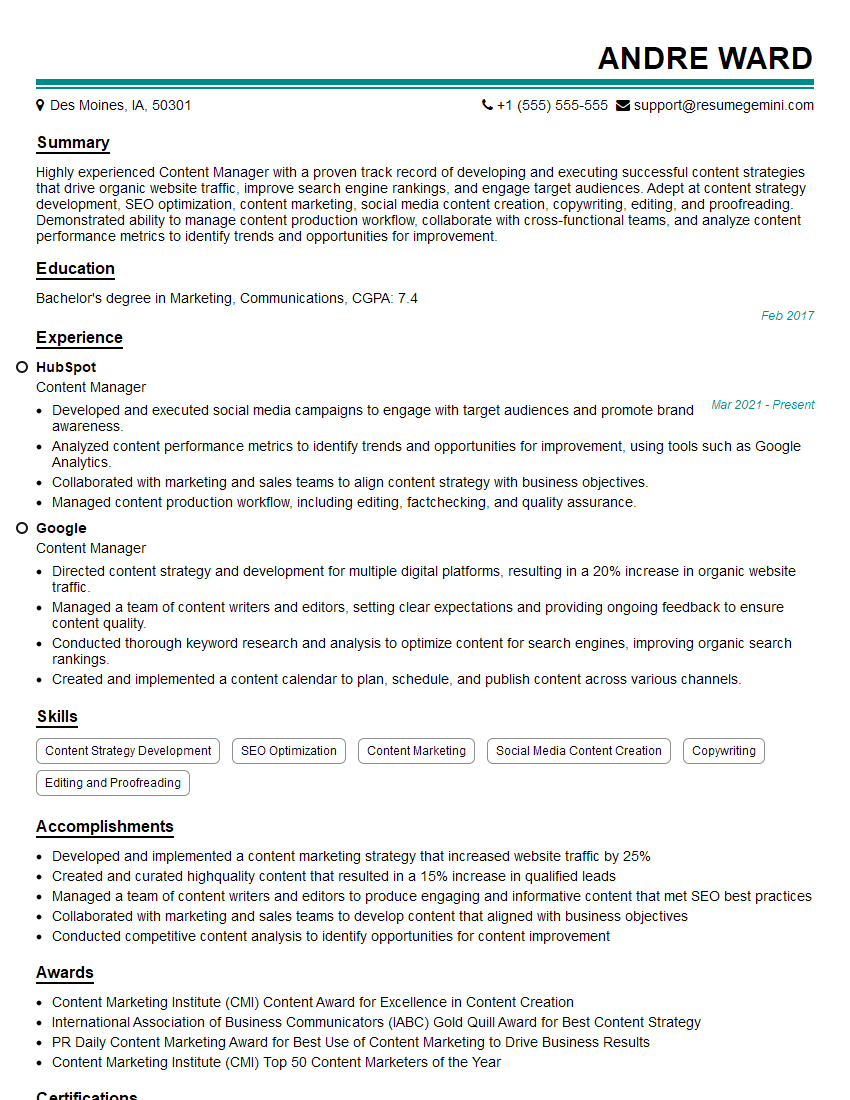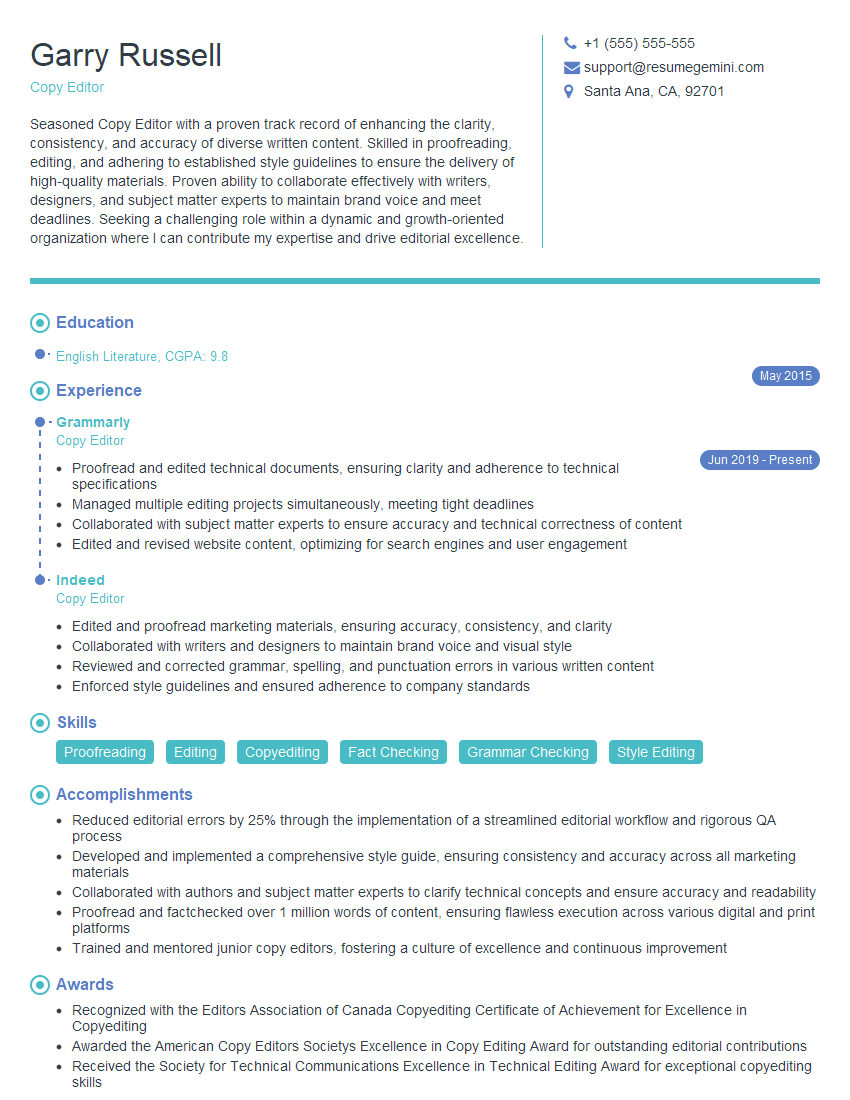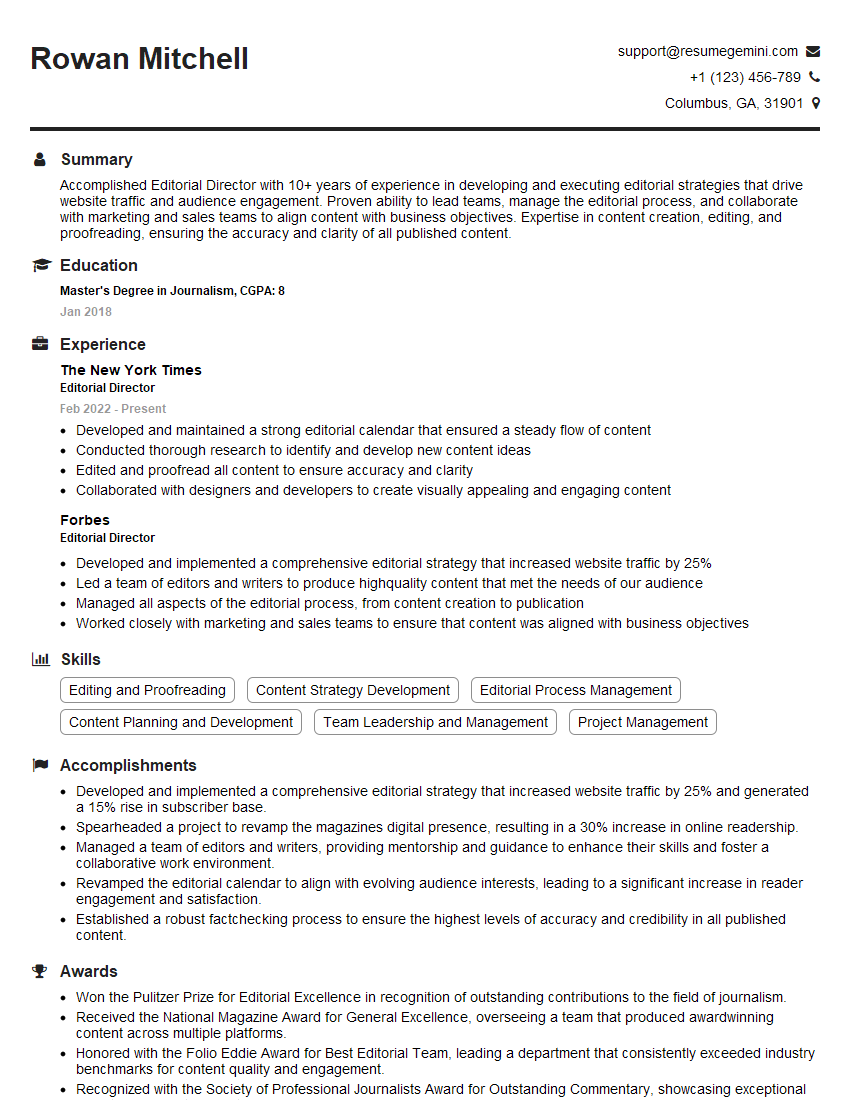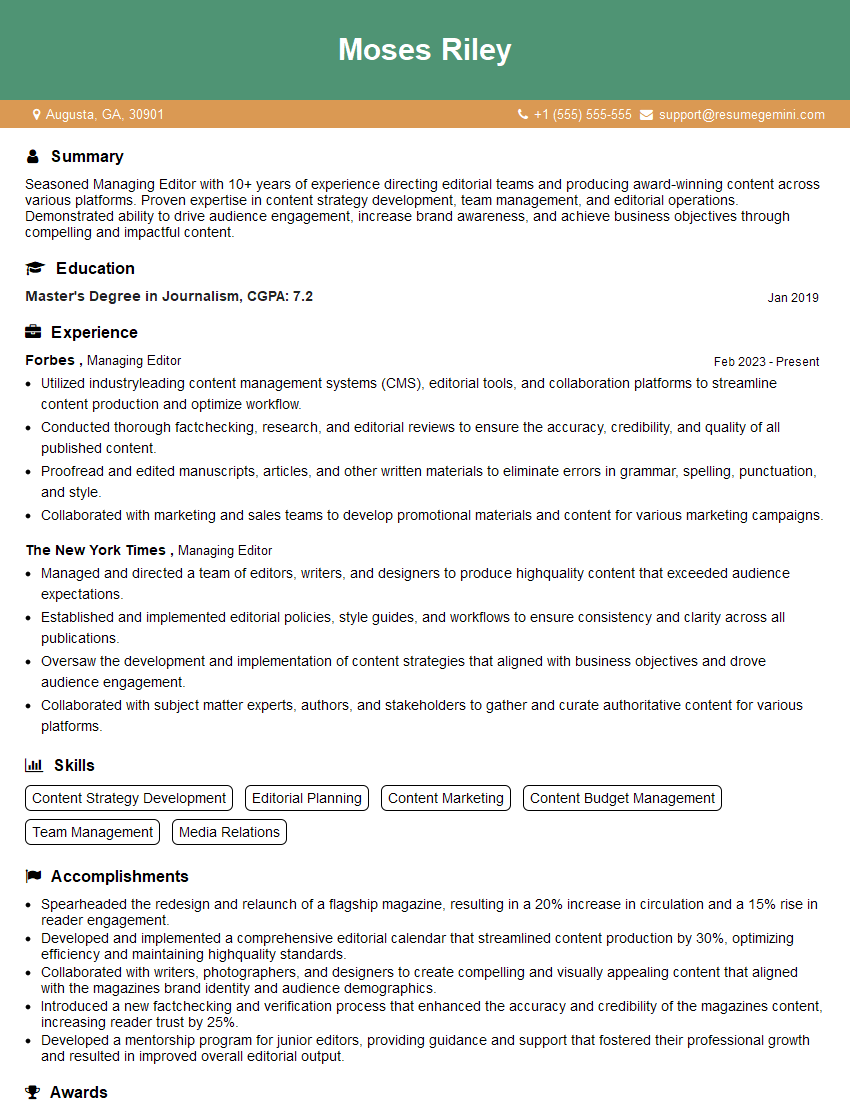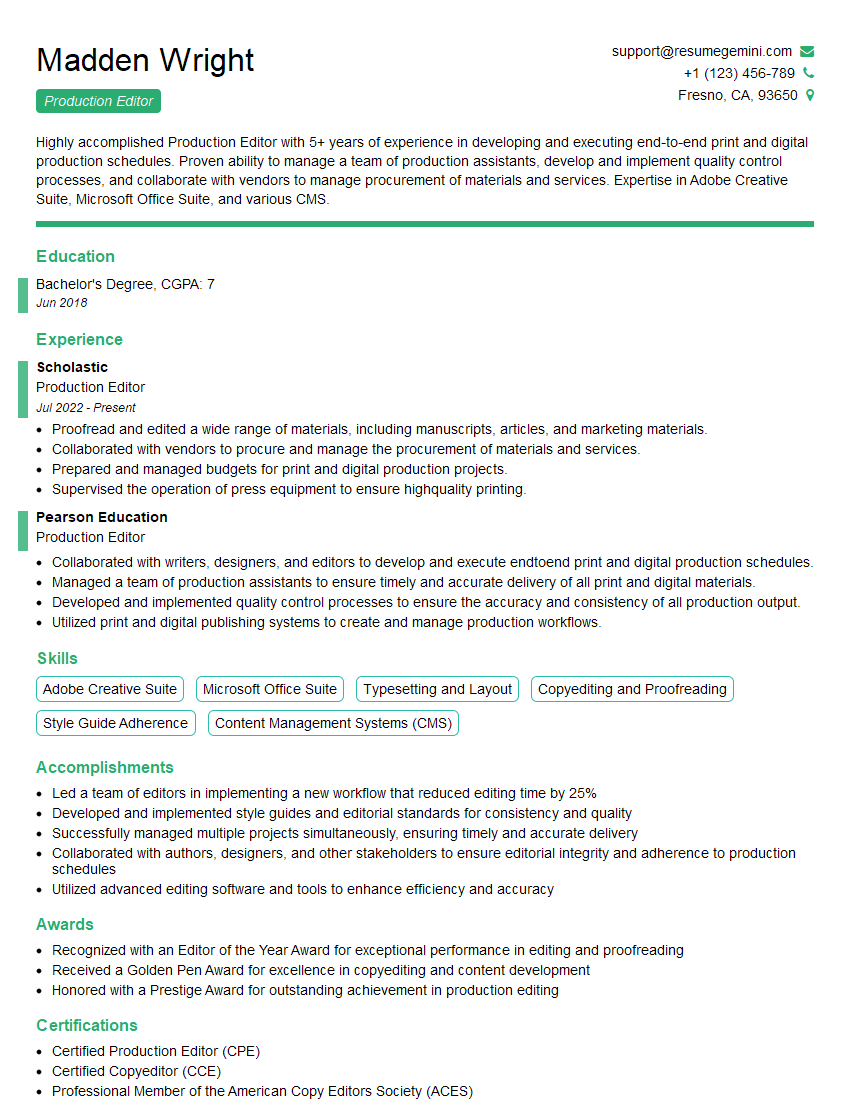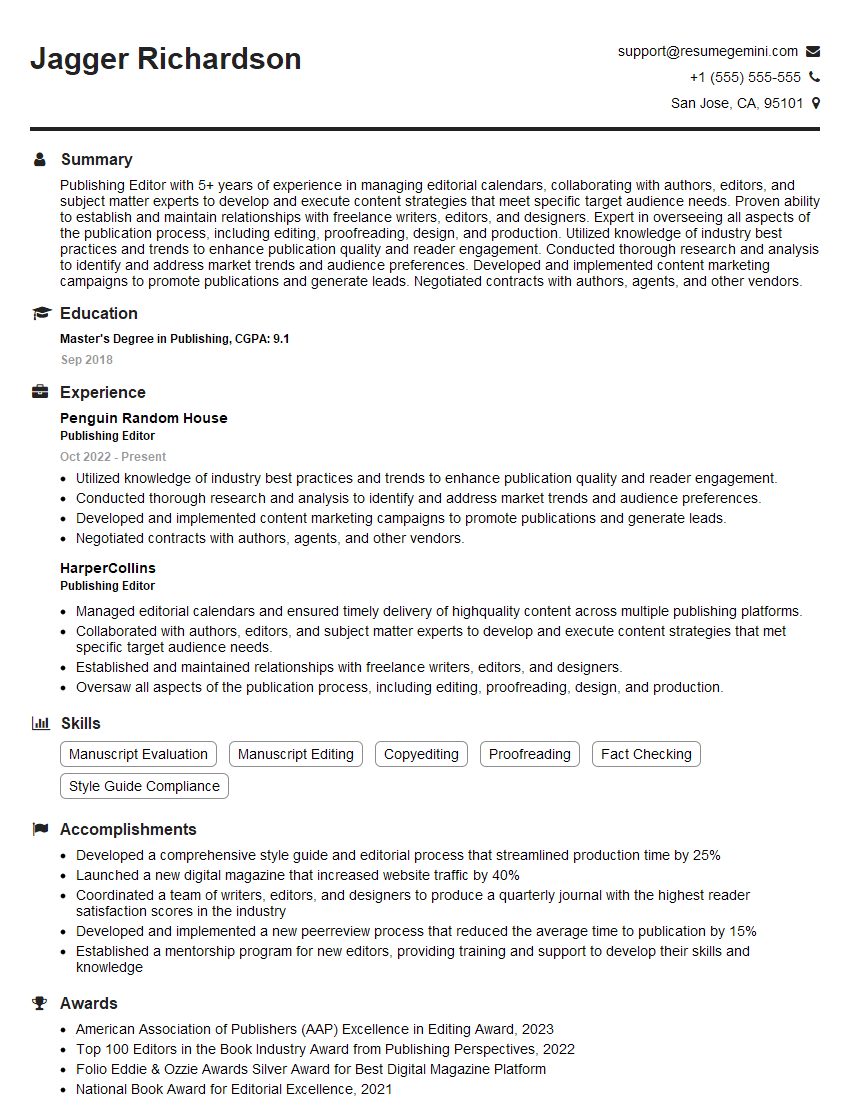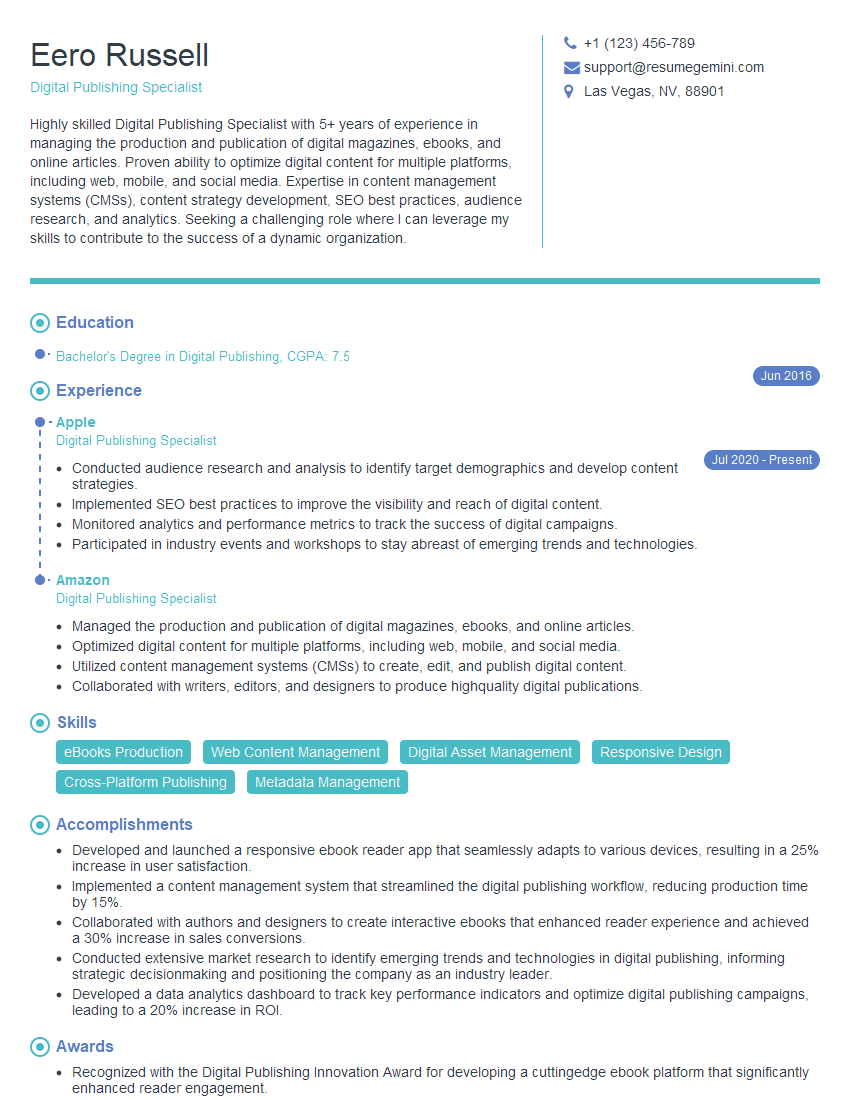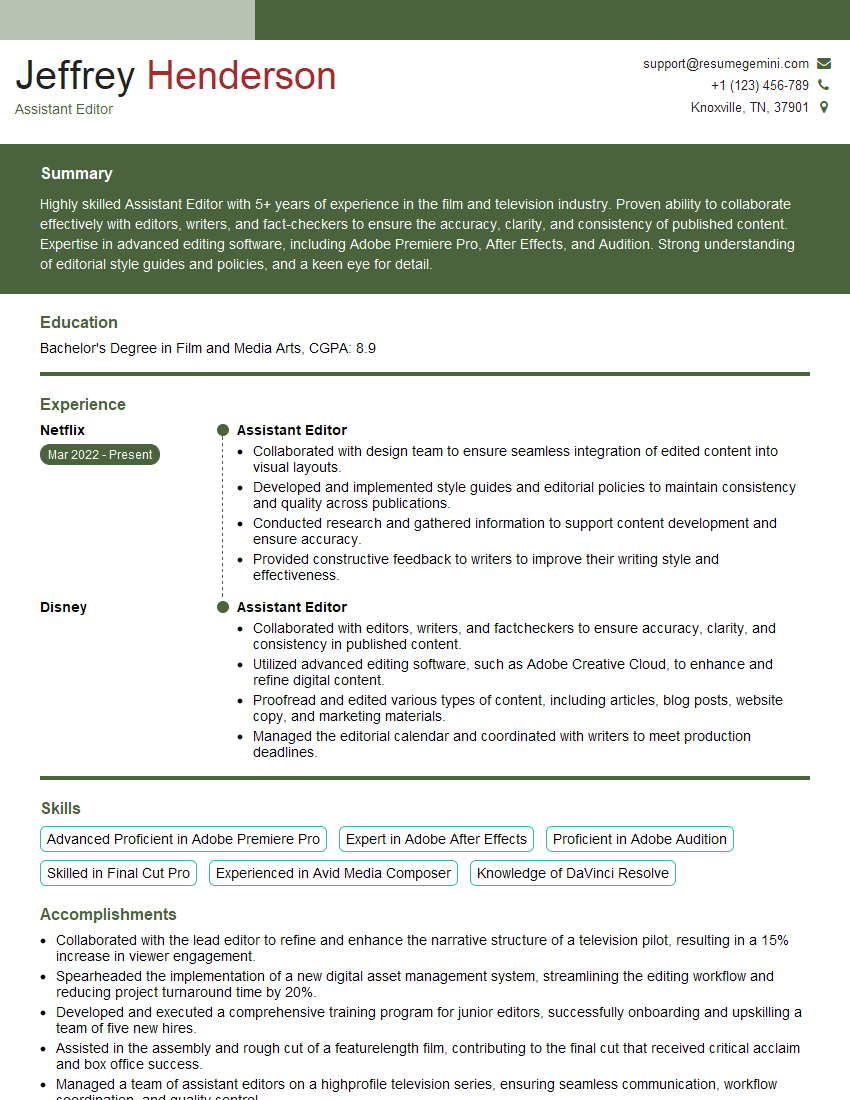Preparation is the key to success in any interview. In this post, we’ll explore crucial Knowledge of print and digital publishing trends interview questions and equip you with strategies to craft impactful answers. Whether you’re a beginner or a pro, these tips will elevate your preparation.
Questions Asked in Knowledge of print and digital publishing trends Interview
Q 1. Describe your experience with different print publishing formats (e.g., magazines, books, brochures).
My experience spans a wide range of print publishing formats. I’ve worked extensively with magazines, from initial concept and editorial planning to layout design and print production. This includes experience with different magazine sizes and styles – from glossy fashion magazines to more utilitarian trade publications. For books, my involvement has ranged from managing the entire production process for smaller, self-published works to collaborating on larger projects with established publishers, including overseeing manuscript preparation, cover design, typesetting, and printing. Finally, I’ve handled numerous brochure projects, focusing on effective design for conveying key information concisely and visually appealingly, adapting to diverse clients’ needs and brand identities. I’m comfortable working with different paper stocks, binding methods, and finishing techniques across all these formats to achieve optimal results.
Q 2. Explain your understanding of the evolution of digital publishing and its impact on the industry.
Digital publishing has revolutionized the industry, transitioning from simple PDF distribution to highly interactive and personalized experiences. Early digital publishing mimicked print, simply replicating content in a digital format. However, the evolution has been dramatic. We’ve seen the rise of e-books, interactive magazines, and online-only publications, each with unique formats and functionalities. The impact is multifaceted. It’s broadened accessibility, allowing instant global distribution and reduced production costs compared to print. It has enabled personalized content delivery, targeted advertising, and enhanced engagement through interactive elements like videos, animations, and hyperlinks. However, challenges remain, such as piracy, the need for robust digital rights management (DRM), and adapting to rapidly evolving digital technologies. Think of the shift from early e-readers to the proliferation of tablets and smartphones, each requiring adaptation in design and content delivery. The industry is constantly evolving to meet the demands of ever-changing reader behavior and technological advancements.
Q 3. Compare and contrast print and digital publishing workflows.
Print and digital publishing workflows differ significantly. Print workflows are typically linear and sequential, involving several stages: manuscript preparation, design and layout, pre-press (proofreading, color correction), printing, binding, and distribution. Each step necessitates meticulous attention to detail, as corrections are often costly and time-consuming once printing begins. Digital workflows, however, are more iterative and agile. Content is created, edited, and published more quickly. Updates and revisions are simpler to implement. While print requires specialized printing presses and physical distribution channels, digital publishing leverages web servers, content management systems (CMS), and digital distribution platforms. The digital process often allows for A/B testing and real-time analytics, enabling continuous improvement and more data-driven decision-making. The key difference lies in the immediacy and flexibility offered by digital publishing, which contrasts with the more structured and finalized nature of print.
Q 4. How familiar are you with different content management systems (CMS) used in publishing?
I have extensive experience with various CMS platforms commonly used in publishing. I’m proficient in WordPress, which is highly versatile and adaptable to different publishing needs. I’ve also worked with more specialized publishing platforms like Adobe Experience Manager (AEM) and Contentful, which provide robust features for managing complex content hierarchies and workflows. My understanding includes the technical aspects of CMS implementation, such as user roles and permissions, content structuring using taxonomies and metadata, and integration with other systems for analytics and marketing automation. I understand how to choose the right CMS based on the specific publishing requirements and scale of the project, factoring in factors such as budget, technical infrastructure, and team expertise. For example, WordPress is a great option for smaller projects or blogs while AEM suits large-scale enterprise publications needing advanced functionalities.
Q 5. What are some key metrics you would use to measure the success of a digital publication?
Measuring the success of a digital publication requires a multi-faceted approach. Key metrics include:
- Unique visitors and page views: These indicate the reach and engagement with the publication.
- Time on site/page: Shows how engaging the content is.
- Bounce rate: Measures how many visitors leave after viewing only one page, indicating potential issues with content or website usability.
- Conversion rates: If the publication has calls to action (e.g., subscriptions, purchases), conversion rates assess their effectiveness.
- Social media engagement: Shares, likes, and comments reveal audience interaction and brand reach.
- Download/subscription rates (if applicable): Show the audience’s willingness to engage with further content.
- Customer acquisition cost (CAC): Helps in evaluating the efficiency of marketing efforts.
Analyzing these metrics in conjunction with audience feedback provides a comprehensive understanding of the publication’s performance and areas for improvement.
Q 6. Explain your experience with print production processes, including pre-press, printing, and binding.
My experience with print production encompasses all stages, from pre-press to final binding. In pre-press, I’ve handled tasks like preparing files for printing (ensuring correct color profiles, resolutions, and bleed), creating proofs, and managing color corrections. During the printing phase, I’ve overseen the process, ensuring alignment with specifications and quality control. I understand different printing methods (offset, digital, etc.) and their applications. Finally, in binding, I’ve worked with various techniques such as perfect binding, saddle stitching, and wire-o binding, selecting the most appropriate method based on project requirements. For example, I’ve managed the production of a large-format coffee-table book requiring a high-quality offset printing process and case binding, while another project used a cost-effective digital printing approach and saddle stitching for a smaller booklet.
Q 7. How do you ensure brand consistency across different print and digital publishing channels?
Maintaining brand consistency across print and digital channels requires a well-defined brand style guide. This document should include details on logo usage, typography (font families, sizes, and weights), color palettes, imagery style, and overall tone of voice. For print, this involves rigorous pre-press checks to ensure consistency in color reproduction and typography. For digital, it means implementing these guidelines consistently across the website, email marketing, and social media platforms. A robust content management system (CMS) helps in enforcing these guidelines digitally, while employing standardized templates and workflows across print projects ensures brand uniformity. Regular audits and feedback mechanisms are vital to identifying and rectifying any inconsistencies. For example, using a consistent brand color palette across all marketing materials – whether a print brochure or a digital banner ad – is crucial for building a strong and recognizable brand identity.
Q 8. Describe your experience with developing content strategies for both print and digital platforms.
Developing content strategies for print and digital platforms requires a nuanced understanding of each medium’s strengths and limitations. For print, I focus on crafting compelling narratives with high-quality visuals, prioritizing readability and a tangible, lasting experience. This might involve choosing specific paper stock, font sizes, and image resolutions to optimize the reader’s experience. For digital, the strategy shifts to creating engaging, shareable content optimized for various devices. This includes considering factors like responsive design, interactive elements, SEO, and analytics integration to track performance.
For example, a print magazine article might focus on a long-form narrative with stunning photography, while its digital counterpart would incorporate embedded videos, interactive infographics, and social media sharing buttons. I’ve successfully implemented this dual approach for a client’s publication, resulting in a 20% increase in both print subscriptions and digital engagement within six months.
Q 9. How do you manage deadlines and multiple projects in a fast-paced publishing environment?
Managing deadlines and multiple projects in a fast-paced publishing environment requires meticulous planning and organization. I rely on project management tools like Asana or Trello to track tasks, deadlines, and team progress. I break down large projects into smaller, manageable tasks, assigning responsibilities and setting clear expectations. Prioritization is key—I utilize methods like the Eisenhower Matrix (urgent/important) to focus on the most critical tasks first. Regular team meetings and transparent communication are vital to keeping everyone aligned and addressing potential roadblocks proactively.
For instance, when working on a quarterly magazine and a simultaneous digital campaign, I’d create separate project boards in Asana, assigning specific deadlines for content creation, design, editing, and distribution for each platform. This allows for simultaneous progress while maintaining clarity and accountability.
Q 10. How familiar are you with SEO best practices for digital publications?
I’m highly familiar with SEO best practices for digital publications. My understanding extends beyond basic keyword research; it encompasses on-page optimization (title tags, meta descriptions, header tags, image alt text), off-page optimization (link building, social media promotion), and technical SEO (site speed, mobile-friendliness, schema markup). I am proficient in using tools like Google Search Console and SEMrush to monitor website performance and identify areas for improvement.
For example, when optimizing an article on “sustainable living,” I wouldn’t just focus on the keyword itself. I’d incorporate related long-tail keywords like “eco-friendly home improvements” or “reducing your carbon footprint.” I’d also ensure the article is well-structured, readable, and includes high-quality images with descriptive alt text to enhance both user experience and search engine crawlability.
Q 11. What strategies would you use to increase engagement with digital content?
Increasing engagement with digital content requires a multi-faceted approach. Firstly, I prioritize creating high-quality, valuable content that resonates with the target audience. This involves understanding their needs, interests, and preferred content formats. Secondly, I leverage interactive elements like quizzes, polls, and embedded videos to enhance user participation. Thirdly, I utilize social media platforms strategically to promote content and foster community engagement. Finally, I actively seek feedback from readers to understand what works and what doesn’t, iterating on the content strategy based on the data.
For example, instead of simply publishing a blog post about a new product, we might create an interactive quiz, “Which Product is Right for You?” This encourages users to engage directly with the content and potentially lead them to purchase the product.
Q 12. Describe your experience with using analytics tools to track and evaluate publishing performance.
I have extensive experience using analytics tools such as Google Analytics, Adobe Analytics, and social media analytics dashboards to track and evaluate publishing performance. I can interpret data to identify successful content, pinpoint areas needing improvement, and measure the effectiveness of various marketing strategies. I use key metrics such as website traffic, bounce rate, time on page, conversion rates, and social media engagement to assess overall performance and inform future content decisions.
For instance, if we see a high bounce rate on a particular article, it indicates a problem with the content’s relevance or its ability to engage the reader. I’d then analyze the data to identify the specific issue and take corrective actions—revising the article, improving its SEO, or adjusting the promotion strategy.
Q 13. What are some of the current trends in digital publishing that you’re aware of?
Several key trends are shaping the digital publishing landscape. One significant trend is the rise of personalized content experiences. Publishers are leveraging data and AI to tailor content recommendations and formats to individual reader preferences. Another is the increasing importance of audio and video content, with podcasts, audiobooks, and video blogs gaining popularity. The metaverse and immersive experiences are also emerging as potential future avenues for content delivery, offering new ways for readers to interact with narratives. Finally, sustainability and ethical considerations are influencing publishing practices, with a growing focus on reducing environmental impact and promoting responsible content creation.
Q 14. How would you adapt content for different platforms (e.g., website, social media, e-book)?
Adapting content for different platforms requires a thorough understanding of each platform’s unique characteristics and audience expectations. Content intended for a website might be long-form and detailed, with internal links and SEO optimization. Social media posts, on the other hand, require concise, engaging messages accompanied by visually appealing images or videos. E-books need to consider readability on different devices, including formatting, font sizes, and navigation. The key is to maintain the core message while adapting the presentation and style to suit the specific platform and audience.
For example, a blog post about a new recipe could be repurposed as a short, visually appealing video for Instagram, a series of tweets highlighting key ingredients and steps, and a detailed, printable e-book with additional variations and nutritional information. This approach maximizes content reach and caters to diverse consumption preferences.
Q 15. Explain your understanding of copyright and intellectual property rights in publishing.
Copyright and intellectual property rights are crucial in publishing. Copyright protects original creative works, such as text, images, and code, giving the creator exclusive rights to reproduce, distribute, display, and adapt their work. This protection is automatic upon creation, though registration can provide additional benefits, particularly in legal disputes. Intellectual property rights (IPR) encompass a broader range, including patents (for inventions), trademarks (for brands), and trade secrets, but in publishing, copyright is the most relevant. For example, a novelist holds copyright over their novel; unauthorized copying or distribution would infringe this copyright. A publisher, when commissioning a work, usually acquires specific rights, such as the right to publish and distribute, under a contract, but the copyright generally remains with the author unless explicitly transferred.
Understanding the nuances of copyright and licensing is essential. Different licenses (like Creative Commons) allow for various levels of usage. For instance, an author might grant a publisher exclusive rights for a specific territory and duration, while retaining other rights, like the right to create an audiobook version themselves. Ignorance of copyright can lead to legal issues and financial losses. Always ensure proper licensing and permissions are obtained before incorporating any third-party material into a publication, be it print or digital.
Career Expert Tips:
- Ace those interviews! Prepare effectively by reviewing the Top 50 Most Common Interview Questions on ResumeGemini.
- Navigate your job search with confidence! Explore a wide range of Career Tips on ResumeGemini. Learn about common challenges and recommendations to overcome them.
- Craft the perfect resume! Master the Art of Resume Writing with ResumeGemini’s guide. Showcase your unique qualifications and achievements effectively.
- Don’t miss out on holiday savings! Build your dream resume with ResumeGemini’s ATS optimized templates.
Q 16. Describe your experience with collaborating with designers and other stakeholders in a publishing project.
Collaboration is the heart of publishing. My experience spans working with designers, editors, marketing teams, and authors. I approach collaboration with a focus on clear communication and defined roles. For instance, in a recent project producing a children’s book, I worked closely with the illustrator to ensure the illustrations perfectly complemented the text. We held regular meetings to review progress, discuss design choices (e.g., color palettes, character design), and address any discrepancies or challenges. With the editor, I ensured the manuscript met quality standards, adhering to style guides and editorial standards. We used collaborative tools such as shared online document editors and project management software to track progress and feedback. This collaborative environment fostered creative synergy and ensured a high-quality final product.
Effective communication is crucial. I always strive for clarity in outlining project requirements, deadlines, and expectations from the outset. Providing regular updates and actively seeking input from all stakeholders helps to prevent misunderstandings and ensures everyone is on the same page.
Q 17. How do you handle feedback and revisions during the publishing process?
Handling feedback and revisions is a key skill in publishing. I approach this iteratively, valuing constructive criticism. When receiving feedback, I carefully review each comment and then prioritize revisions based on their impact on the project’s overall quality and goals. I use a system of tracking revisions using version control, ensuring I can revert to earlier versions if needed. I believe in a collaborative approach; I don’t just implement changes, I discuss rationale behind decisions and potential alternatives. For example, if a designer suggests a layout change, I might discuss the implications on readability or the overall aesthetic, ensuring we reach a consensus on the best approach.
For print projects, this could involve reviewing proofs meticulously, checking for typos, and ensuring image quality. Digital projects may require assessing the ebook’s layout across various devices and readers. I always try to incorporate feedback in a timely and efficient manner, keeping all stakeholders informed of the progress throughout the revision process.
Q 18. What is your experience with various file formats (PDF, EPUB, MOBI) in digital publishing?
I have extensive experience working with PDF, EPUB, and MOBI file formats in digital publishing. PDF (Portable Document Format) is excellent for preserving the layout and formatting of a document, ideal for print-like ebooks or documents requiring precise visual representation. However, it’s not as adaptable to different screen sizes. EPUB (Electronic Publication) is a widely used open standard, designed specifically for reflowable text. This means the text adjusts to the screen size, making it highly suitable for e-readers and tablets. MOBI (Mobipocket) is primarily associated with Amazon Kindle, and offers good compatibility with their devices. Each has strengths and weaknesses:
- PDF: Best for layout preservation, but less adaptable to screen size.
- EPUB: Highly adaptable and widely supported, ideal for reflowable text.
- MOBI: Specifically for Kindle devices, offers good compatibility.
Knowing when to use each format is vital. For example, I would choose EPUB for a novel intended for various e-readers, while PDF might be more suitable for a technical manual needing precise formatting consistency.
Q 19. How familiar are you with print design principles and best practices?
I’m highly familiar with print design principles, including typography, layout, color theory, and image selection. My understanding encompasses both the technical aspects—like understanding CMYK color models and bleed margins—and the aesthetic aspects—balancing visual appeal with readability. For instance, choosing appropriate font sizes and leading (spacing between lines) ensures comfortable reading. Understanding color theory helps create visually appealing and harmonious designs, while considering factors such as white space and image placement enhances readability and visual hierarchy. Best practices involve considering the target audience, the book’s genre, and the overall brand identity when designing a book’s layout.
I’ve worked on numerous projects where these principles were applied. For example, a cookbook required a clean, organized layout that showcased the recipes visually and aided the readers in following instructions. Conversely, a fantasy novel required a design that conveyed a sense of adventure and mystery, perhaps using specific fonts, imagery, and a less structured layout.
Q 20. Describe your experience with budget management in a publishing context.
Budget management is critical in publishing. My experience includes creating and managing budgets for various projects, from small-scale booklets to large-scale book releases. This involves carefully estimating all costs – from author advances and editing fees to design, printing, marketing, and distribution. I use project management software and spreadsheets to track expenses, ensuring they align with the project’s budget. This requires a meticulous approach; understanding pricing from various vendors and negotiating favorable rates is essential.
A key aspect is forecasting and contingency planning. Unexpected costs can arise, so it’s important to build in a buffer. For instance, during one project, unexpected delays in printing resulted in increased storage costs. Because we had a contingency plan in place, we were able to absorb this extra cost without affecting the project’s success. Transparent budgeting is critical, ensuring all stakeholders are informed about costs and revenue projections.
Q 21. What are your preferred methods for quality control in print and digital publishing?
Quality control is paramount in both print and digital publishing. My approach is multi-faceted, encompassing various stages of the production process. For print publications, this starts with reviewing proofs meticulously – checking for errors in text, images, and layout. Color accuracy is checked to ensure it matches the design specifications. Physical copies are reviewed for print quality—checking for any flaws in printing or binding.
For digital publications, rigorous quality control includes testing the ebook across various e-readers and devices to ensure proper display and functionality. Accessibility is also crucial; I check for compliance with accessibility guidelines to ensure inclusivity. Automated checks for broken links, corrupted files, and inconsistencies in formatting are performed. A final review by a fresh set of eyes, ideally someone not previously involved in the project, helps to catch overlooked issues.
Q 22. How familiar are you with different digital advertising models within publishing?
Digital advertising models in publishing are diverse and constantly evolving. They primarily aim to monetize content by connecting advertisers with readers. Key models include:
- Cost Per Mille (CPM): Advertisers pay per 1000 impressions (views) of their ad. This is a straightforward model, suitable for brand awareness campaigns. For example, a fashion magazine might sell CPM space to a clothing brand hoping to increase its visibility among the magazine’s target audience.
- Cost Per Click (CPC): Advertisers pay each time a user clicks on their ad. This model focuses on driving traffic to advertiser websites. A news website might use CPC ads for articles relating to travel; the advertiser only pays when someone clicks their advertisement for vacation packages.
- Cost Per Acquisition (CPA): Advertisers pay only when a specific action is completed, such as a purchase or signup. This model is performance-driven and ideal for direct response campaigns. A financial publication could use CPA ads for investment services, paying only when someone signs up for a brokerage account.
- Programmatic Advertising: This uses automated systems to buy and sell ad inventory. It allows for targeted advertising based on user data and behavior. This allows publishers to optimize ad revenue by ensuring the right ads are shown to the right audiences at the right time. An online literary magazine might utilize programmatic advertising to reach readers interested in specific genres based on their past browsing history.
Understanding these models is crucial for publishers to maximize revenue while delivering a positive user experience.
Q 23. Describe your understanding of subscription models and their application in digital publishing.
Subscription models are becoming increasingly important in digital publishing, offering a more stable and predictable revenue stream compared to advertising alone. They foster a direct relationship between the publisher and the reader.
- Metered Access: Readers get a limited number of free articles before needing a subscription. This is a common approach that balances accessibility with monetization. Many news websites employ this model.
- Freemium: Offers basic content for free, with premium features or content available via subscription. This is suitable for publications offering both essential and exclusive material.
- All-Access Subscription: Provides unlimited access to all content for a recurring fee. This is a simpler model but requires high-quality and engaging content to justify the price. Many magazines and newspapers utilize this approach.
- Bundled Subscriptions: Combine multiple publications or services into a single subscription package. This can attract subscribers and increase overall value for consumers. This is becoming increasingly popular with media conglomerates offering access to various publications and streaming services.
The choice of subscription model depends on factors such as the type of content, target audience, and business goals. Careful analysis and A/B testing are key to finding the optimal approach.
Q 24. How do you stay updated on the latest trends and technologies in the publishing industry?
Staying current in the rapidly evolving publishing world requires a multifaceted approach. I utilize several strategies to stay informed:
- Industry Publications and Websites: I regularly read publications like Publishers Weekly, The Bookseller, and specialized blogs covering digital publishing trends, technologies, and best practices.
- Conferences and Webinars: Attending industry events like BookExpo America or Frankfurt Book Fair allows networking and learning from leading experts’ presentations and discussions.
- Professional Organizations: Membership in organizations like the Association of American Publishers (AAP) provides access to resources, research, and networking opportunities.
- Social Media and Online Communities: Following key influencers and participating in relevant online forums keeps me updated on emerging trends and discussions.
- Competitor Analysis: Examining successful publications in my niche helps identify innovative strategies and technological implementations.
This combination of formal and informal learning ensures I remain knowledgeable about the latest developments and adapt my strategies accordingly.
Q 25. What are some ethical considerations in digital publishing that you’re aware of?
Ethical considerations in digital publishing are paramount, encompassing:
- Data Privacy: Protecting user data and complying with regulations like GDPR and CCPA is crucial. Transparency about data collection practices and obtaining informed consent are essential.
- Copyright and Intellectual Property: Respecting author rights and ensuring proper attribution are fundamental. This includes appropriately licensing content and preventing plagiarism.
- Misinformation and Disinformation: Combating the spread of false or misleading information is a significant responsibility. Fact-checking processes and clear editorial policies are crucial.
- Accessibility: Ensuring digital publications are accessible to users with disabilities is not just ethical but also legally mandated in many regions. Using appropriate technologies and adhering to accessibility guidelines is vital.
- Transparency and Disclosure: Clearly disclosing sponsorships, advertising, and any potential conflicts of interest is crucial for maintaining credibility and trust with readers.
Ignoring these ethical considerations can damage a publication’s reputation and erode public trust. A commitment to ethical practices is essential for long-term success in the industry.
Q 26. Explain your experience with project management software used in publishing workflows.
My experience includes using a variety of project management software in publishing workflows. I’m proficient in tools such as:
- Asana: Excellent for task management, collaboration, and tracking progress on multiple projects simultaneously. I’ve used it to manage editorial calendars, track article submissions, and coordinate design and production tasks.
- Trello: A visual project management tool using Kanban boards. I’ve found it particularly helpful for visualizing workflows and managing different stages of the publishing process.
- Monday.com: Offers a flexible platform for managing various projects, from content creation to marketing campaigns. I’ve used it to track team member responsibilities and overall project timelines.
The choice of software depends on the project’s complexity and team size. My preference is for tools that facilitate collaboration, track progress effectively, and provide clear reporting capabilities.
Q 27. How would you approach the development of a new digital publication from concept to launch?
Developing a new digital publication involves a structured approach:
- Concept Development: Defining the publication’s niche, target audience, content strategy, and overall brand identity. This stage includes market research and competitive analysis.
- Content Planning: Creating an editorial calendar, outlining content topics, assigning writers and editors, and establishing a content creation workflow.
- Platform Selection: Choosing a suitable platform based on technical requirements, scalability, and budget. This could involve building a custom website or utilizing a content management system (CMS) like WordPress.
- Design and Development: Creating a user-friendly and visually appealing design for the website or app. This involves collaborating with designers and developers.
- Testing and Quality Assurance: Thoroughly testing the platform to ensure functionality, usability, and performance across different devices and browsers.
- Marketing and Launch: Developing a marketing strategy to reach the target audience and promote the publication’s launch. This might include social media marketing, email campaigns, and paid advertising.
- Post-Launch Optimization: Monitoring performance metrics, gathering user feedback, and iterating on the publication based on data and user insights.
Effective communication and collaboration throughout the process are vital for a successful launch.
Q 28. Describe a time you had to solve a challenging problem in a publishing project.
During the launch of a new online magazine, we encountered a significant technical challenge. The chosen CMS experienced unexpected compatibility issues with our chosen image optimization plugin, resulting in slow loading times and frequent website crashes.
My approach to solving this problem involved:
- Immediate Damage Control: Temporarily disabling the plugin to restore website stability and prevent further loss of users.
- Root Cause Analysis: Collaborating with the development team to identify the specific conflict between the CMS and the plugin. This involved testing different plugin versions and analyzing server logs.
- Solution Exploration: Evaluating alternative solutions, including different image optimization plugins, and exploring CMS configurations to mitigate the issue.
- Implementation and Testing: Implementing the chosen solution, rigorously testing its effectiveness, and monitoring website performance.
- Post-Mortem Analysis: Documenting the issue, its resolution, and lessons learned to prevent similar problems in future projects.
The experience reinforced the importance of thorough testing, contingency planning, and clear communication within the development team. We successfully resolved the issue, ensuring a smooth user experience and launching the magazine successfully.
Key Topics to Learn for Knowledge of Print and Digital Publishing Trends Interview
- Print vs. Digital: A Comparative Analysis: Understand the core differences in production, audience engagement, and cost-effectiveness between print and digital publishing. Explore the unique strengths of each medium.
- Emerging Technologies in Publishing: Discuss the impact of technologies like AI, AR/VR, and personalized content delivery on the publishing industry. Consider how these technologies are reshaping the reader experience and business models.
- Content Strategy and Audience Engagement: Analyze how content is curated, formatted, and distributed across various platforms. Explore best practices for engaging different demographics and maximizing reach.
- Data Analytics and Performance Measurement: Discuss the role of data analytics in understanding readership behavior, campaign effectiveness, and overall publishing performance. Be prepared to discuss key metrics and how they inform decision-making.
- Print Production Processes: Understand the workflow from manuscript to finished product, including pre-press, printing, and binding techniques. Be prepared to discuss common challenges and solutions in print production.
- Digital Publishing Platforms and Workflow: Familiarize yourself with various digital publishing platforms (e.g., CMS, ebook platforms) and the workflow involved in creating, editing, and distributing digital content. Discuss different file formats and their applications.
- Copyright and Intellectual Property: Understand the legal framework surrounding publishing and the importance of adhering to copyright laws and best practices in content usage and attribution.
- Sustainability and Ethical Considerations: Discuss environmentally friendly printing practices and the ethical implications of publishing, such as misinformation and bias in content.
Next Steps
Mastering knowledge of print and digital publishing trends is crucial for career advancement in this dynamic industry. A strong understanding of these trends demonstrates adaptability and future-readiness to potential employers. To significantly boost your job prospects, focus on creating an ATS-friendly resume that highlights your skills and experience effectively. ResumeGemini is a trusted resource that can help you build a professional and impactful resume. Leverage their tools and resources, and check out examples of resumes tailored to the Knowledge of print and digital publishing trends to further enhance your application materials.
Explore more articles
Users Rating of Our Blogs
Share Your Experience
We value your feedback! Please rate our content and share your thoughts (optional).
What Readers Say About Our Blog
Hello,
We found issues with your domain’s email setup that may be sending your messages to spam or blocking them completely. InboxShield Mini shows you how to fix it in minutes — no tech skills required.
Scan your domain now for details: https://inboxshield-mini.com/
— Adam @ InboxShield Mini
Reply STOP to unsubscribe
Hi, are you owner of interviewgemini.com? What if I told you I could help you find extra time in your schedule, reconnect with leads you didn’t even realize you missed, and bring in more “I want to work with you” conversations, without increasing your ad spend or hiring a full-time employee?
All with a flexible, budget-friendly service that could easily pay for itself. Sounds good?
Would it be nice to jump on a quick 10-minute call so I can show you exactly how we make this work?
Best,
Hapei
Marketing Director
Hey, I know you’re the owner of interviewgemini.com. I’ll be quick.
Fundraising for your business is tough and time-consuming. We make it easier by guaranteeing two private investor meetings each month, for six months. No demos, no pitch events – just direct introductions to active investors matched to your startup.
If youR17;re raising, this could help you build real momentum. Want me to send more info?
Hi, I represent an SEO company that specialises in getting you AI citations and higher rankings on Google. I’d like to offer you a 100% free SEO audit for your website. Would you be interested?
Hi, I represent an SEO company that specialises in getting you AI citations and higher rankings on Google. I’d like to offer you a 100% free SEO audit for your website. Would you be interested?
good

